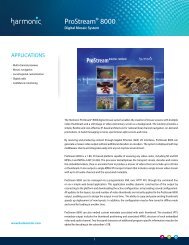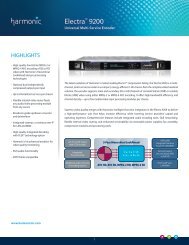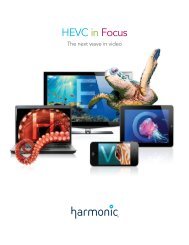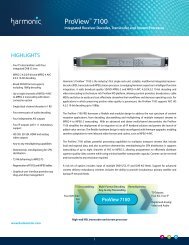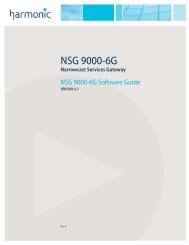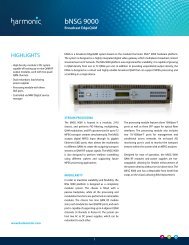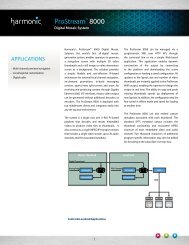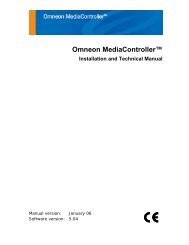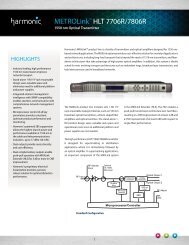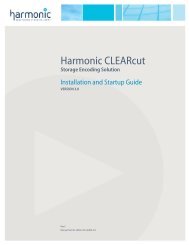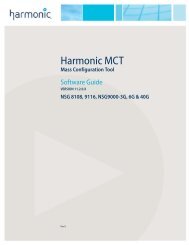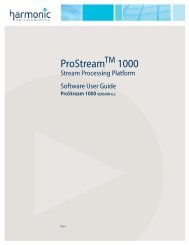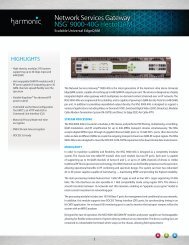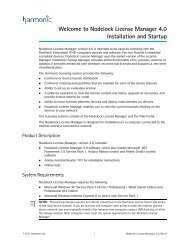Case Study NRK.pdf - Harmonic Inc
Case Study NRK.pdf - Harmonic Inc
Case Study NRK.pdf - Harmonic Inc
Create successful ePaper yourself
Turn your PDF publications into a flip-book with our unique Google optimized e-Paper software.
C A S E S T U D Y<br />
S O L U T I O N A T A G L A N C E<br />
Norwegian broadcaster <strong>NRK</strong> wanted to<br />
transform its production capabilities, both<br />
in its Oslo headquarters and in 13 regional<br />
centers. The requirement was for a free<br />
flow of content from location to location<br />
and producer to producer.<br />
The solution is Programme Bank, probably<br />
the most comprehensive content<br />
management system ever built by a<br />
national broadcaster. It now handles every<br />
piece of content – from news rushes to<br />
imported programs – which appear or are<br />
produced for the three-channel<br />
broadcaster.<br />
Enabling this remarkable power is a large<br />
Omneon file-based infrastructure, including<br />
what may be the largest Omneon MediaGrid<br />
installation in the world.<br />
Find More Online<br />
www.omneon.com<br />
Transforming Regional<br />
Production Operations into a<br />
Single Seamless Infrastructure<br />
Norwegian Broadcasting Corpooration (<strong>NRK</strong>)<br />
The Challenge<br />
Norway’s national broadcaster, <strong>NRK</strong>, has a reputation for implementing bold, innovative<br />
technical solutions. <strong>NRK</strong> already has completed its analog switch-off and now transmits<br />
three television channels over its digital terrestrial network, as well as via satellite. The<br />
broadcaster’s DTT transmission uses MPEG-4 to deliver content to a new generation of<br />
set-top boxes, which means that <strong>NRK</strong> can offer HD content at any time on any of its channels.<br />
In addition to providing television broadcasts, <strong>NRK</strong> also operates a number of radio<br />
stations and has established a strong online presence. The impetus from the top level<br />
of management is that there should be “one <strong>NRK</strong>” with television, radio and online<br />
collaborating closely rather than working in separate silos.<br />
While taking on this challenge and working across multiple media platforms, <strong>NRK</strong> also<br />
must overcome the major obstacle presented by Norway’s mountainous geography, which<br />
is cut through the middle by the Arctic Circle. The broadcaster has its headquarters in<br />
Oslo, with 12 other production centers serving regional interests and a service in the far<br />
north, operated in collaboration with Sweden and Finland, for the Sami peoples. Reaching<br />
across Norway, <strong>NRK</strong> broadcasts do a great deal in bringing the country together.<br />
In 2006, broadcasting to multiple media platforms and multiple regions, <strong>NRK</strong> began<br />
planning a project to institute a tapeless, file-based, multiformat content management<br />
scheme. The solution is known as Programme Bank, and at its heart is one of the world’s<br />
largest implementations of Omneon MediaGrid active storage systems.
C A S E S T U D Y<br />
The Solution<br />
Prior to launching the Programme Bank project, <strong>NRK</strong> already had created two file-based islands. News is managed by a Quantel and<br />
ENPS system, and playout from Oslo is managed by Abit software and Omneon Spectrum video servers. The broadcaster’s 13 regional<br />
centers also have the capability to broadcast autonomously, so each has its own independent playout facilities, originally using Grass<br />
Valley Profile servers and OmniBus software.<br />
The principle aim of Programme Bank is to bring all production into a single infrastructure. That includes making all news content<br />
accessible via Programme Bank content management, although the ENPS/Quantel infrastructure remains in place for direct production.<br />
The result is that every single piece of content in <strong>NRK</strong> is touched, and in almost all cases totally managed, by Programme Bank.<br />
The system is decentralized. Each of the 12 regions, plus the Sami service, has its own domain, including local storage, to service<br />
local news and regional production. While the regional bases already had content servers, the project is gradually replacing them.<br />
The software is capable of fully integrating third-party systems into Programme Bank, but the replacement of each with a local<br />
Omneon MediaGrid system will be completed by mid-2010.<br />
The all-encompassing nature of Programme Bank made it necessary for <strong>NRK</strong> to build the largest Omneon MediaGrid network in Europe.<br />
The Oslo deployment of Omneon MediaGrid systems alone has 180 servers and the capacity for 6,400 hours (50 Mb/s MXF) with<br />
a replication factor of three. Across the whole of the Programme Bank network, the capacity of all the connected Omneon storage<br />
systems is around one petabyte.<br />
The fundamental design of the Omneon MediaGrid active storage system is that content is sliced into packages of 2 MB, each of<br />
which is stored a number of times on different drives, not only to provide resilience, but also to provide reliably fast access. At <strong>NRK</strong>,<br />
each slice is stored on three different drives, each in a different frame, greatly minimizing the risk of content bottlenecks.<br />
All Programme Bank content is archived via Front Porch Digital software with a StorageTek tape robot and disk cache. The 150-TB cache<br />
server is managed intelligently to minimize tape access. The StorageTek library has a current capacity of 46,200 hours with all content<br />
stored on two separate tapes for security. Each week, 25 TB of media is added to the archive.<br />
Storage in Oslo is separated into four domains: news, breakfast television, production and the archive, making a total of 17 domains<br />
across <strong>NRK</strong> headquarters and regional sites. There is an 18th, operated by the engineering team implementing the system, which has<br />
access to the rest of the network but is not visible to other users. Each domain is fully autonomous, storing and managing its own<br />
content, and if a domain needs to be taken down for any reason, it does not affect the rest of Programme Bank.<br />
The critical concept underpinning the system is that any user can search the local domain, or any other, or all domains for content.<br />
To make this possible, the networked Omneon MediaGrid storage systems are matched with a sophisticated custom control system<br />
based on the OmniBus Opus G3 platform and a Windows Media browse system from IPV.<br />
The network infrastructure connecting Oslo with the 13 remote sites was developed by <strong>NRK</strong>. Rather than establish dedicated connectivity,<br />
which would have been underutilized much of the time, <strong>NRK</strong> chose a more efficient model, creating a high-capacity, high-availability network<br />
between regions. Within this network Programme Bank exists as a number of virtual LANs. During testing, engineers demonstrated 180<br />
parallel streams of 50-Mb/s IMX video around the Oslo network without any performance degradation.
The Workflow<br />
The in-house format for all <strong>NRK</strong> content is 50 Mb/s in an MXF wrapper (according to the Sony RDD9 standard). While the original<br />
system specification stipulated QuickTime, MXF was deployed instead because it allows access to content as it is being ingested.<br />
Thanks to the power of the IPV encoders, content can be browsed at any desktop within 12 seconds of a recording starting.<br />
Final Cut Pro is <strong>NRK</strong>’s preferred editor, and in this installation FCP can access MXF content directly via the Cinémon plug-in, which<br />
supports edit-in–place functionality on the Omneon storage systems. The broadcaster’s regional centers typically have as many as<br />
30 Final Cut Pro seats, all editing directly on a single Omneon MediaGrid.<br />
All content for playout or production is recorded into Programme Bank. Ingest of externally produced content onto Omneon Spectrum<br />
servers is a separate process that takes place in the transmission area, with newly ingested content passed to Programme Bank as<br />
a background task.<br />
News material in Oslo is ingested onto the Quantel system and then transcoded and transwrapped to be available in Programme<br />
Bank. Regional news production relies on Programme Bank directly, taking advantage of the ability to share content between local<br />
sites and Oslo immediately and seamlessly. The seamless interface is essential because about 25 percent of the content in<br />
national news programs comes from regional sites.<br />
The Oslo domains are based on genres, and production content is recorded direct-to-disk according to this scheme. To support<br />
entertainment programming originated at the Oslo television studios, <strong>NRK</strong> developed additional functionality for Programme Bank.<br />
Light entertainment producers quickly grasped the basics of the Programme Bank concept and realized that the technology would<br />
allow them to record an ISO feed of each studio camera separately. By adding more ports to the Omneon video servers, this model<br />
was easily accommodated.<br />
Another important development, in conjunction with OmniBus, was the addition of live logging, particularly to meet the needs of the many<br />
sports fans in Norway. Templates for each event let operators add metadata simply by clicking buttons. The resulting tags reference not<br />
only individual players, but also the variety of action and even emotion displayed. The metadata is immediately converted to XML so that,<br />
when it is transferred to Final Cut Pro, each logging point appears as a marker. An editor tasked with creating, for example, a package<br />
that looks at all the funny moments in a game simply goes through the appropriate tags to collect all the required clips.
C A S E S T U D Y<br />
Once in Programme Bank, content can be accessed by any authorized user on the system. At the time of writing, some 3,200<br />
desktop computers in <strong>NRK</strong> had the Programme Bank client, which enabled them to search for content and browse the results.<br />
<strong>NRK</strong>’s development team has created a very comprehensive metadata structure that makes searching as easy and as accurate as<br />
possible for all researchers.<br />
A core characteristic of the system is that users can search any or all domains, though each domain remains autonomous. So,<br />
a user in Stavanger can search the content stored in Tromsø, for example, and having found a likely match, can watch a browse<br />
version of the clip virtually instantaneously.<br />
Authorized users have access to basic editing functionality on the desktop, and they can create complete packages using the browse<br />
editor. The EDL is then either conformed automatically inside the MediaGrid or handed on to a craft editor for further refinement.<br />
If content needs to be transferred from one domain to another, this transfer is managed by the Omneon MediaGrid system. Priorities<br />
can be applied so that, for example, news content is always sent first, though the capacity of the high-speed network linking all <strong>NRK</strong><br />
sites means that material can normally be moved faster than real time. Where transcoding needs to take place, this is handled<br />
automatically as part of the transfer.<br />
www.omneon.com<br />
U.S. Headquarters:<br />
1237 E. Arques Ave.<br />
Sunnyvale, CA 94085<br />
ph +1 866.861.5690<br />
ph +1 408.585.5000<br />
fx +1 408.585.5099<br />
<strong>NRK</strong> radio broadcast staff also has access to the system, which<br />
they use to pull audio tracks from television sound tracks. In this<br />
respect, journalists have developed new ways of cooperating. For<br />
instance, television reporters now explain scenes in more detail<br />
so that audio extracted from their reports can be used as sound<br />
bites in radio bulletins. Appropriate content can be transferred to<br />
the radio production system via Telestream FlipFactory.<br />
Online producers use exactly the same tools, creating packages<br />
on desktop editors and putting the finished product into “drop<br />
boxes” for encoding at Web resolution.<br />
The Result<br />
<strong>NRK</strong> set out to transform its production operations into a single<br />
seamless infrastructure that encompassed all content and<br />
empowered all users. To overcome the difficulties of working with<br />
many regional centers across a large country, the broadcaster<br />
undertook the deployment of sophisticated networking and<br />
sharing solutions. The Programme Bank project is nearly<br />
complete, and it is a tribute to the close cooperation of the team<br />
led by <strong>NRK</strong> and strongly supported by Omneon and the other key<br />
development partners that the largest and most comprehensive<br />
content management system attempted anywhere in the world<br />
has been accepted with enthusiasm by its users. As Programme<br />
Bank is put into place and refined, producers are keen to get<br />
connected and already are contributing suggestions for the further<br />
evolution of <strong>NRK</strong>’s innovative file-based multiformat content<br />
management system.<br />
Europe:<br />
5 Lindenwood<br />
Chineham, Basingstoke<br />
RG24 8QY United Kingdom<br />
ph +44 1256.347.400<br />
fx +44 1256.347.410<br />
Japan:<br />
Ginza 3-Chome Bldg. 8F<br />
3-14-1 Ginza, Chuo-ku<br />
Tokyo 104-0061 Japan<br />
ph +81 03.5565.6735<br />
fx +81 03.5565.6736<br />
Asia/Pacific:<br />
20 Loyang Crescent<br />
Singapore 508984<br />
ph +65 6548.0500<br />
fx +65 6548.0504<br />
©2010 Omneon, <strong>Inc</strong>. All rights reserved. Omneon and the Omneon logo are registered trademarks of Omneon, <strong>Inc</strong>. All other<br />
trademarks are the property of the respective companies. Printed in USA | September 2010. The information contained in this<br />
document is subject to change without notice or obligation.



